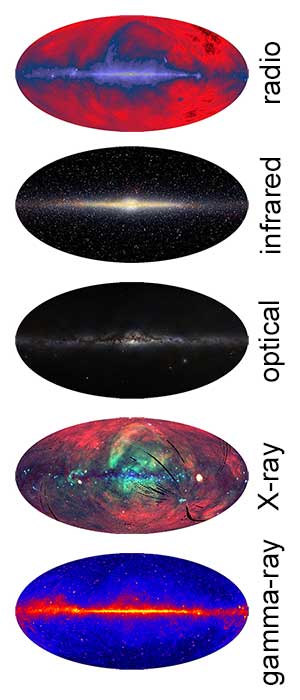Multiwavelength Astronomy
Multiwavelength Astronomy

The sky as seen in different wavelengths. From the top: radio, infrared, optical, X-ray, and gamma-ray. (Click image for a larger version. Credits: radio: Haslam et al. 1982; infrared: NASA; optical: ESO/S. Brunier; X-ray: Max Planck Institute for Extraterrestrial Physics and S. L. Snowden; gamma-ray: NASA/DOE/Fermi LAT Collaboration)
The night sky has always served as a source of wonder and mystery to people. However, it has only been in the past few decades that we have truly begun to 'see' the Universe in all its glory. This is because we have only recently been able to look at the Universe over the entire electromagnetic spectrum. Our Universe contains objects that produce a vast range of radiation with wavelengths either too short or too long for our eyes to see.
Instruments that examine all parts of the electromagnetic (EM) spectrum have been available to us only in the 20th century, since the rocket age was required to get instruments sensitive to the infrared, ultraviolet, X-rays, and gamma-ray wavelengths above the Earth. We had to wait until the rocket age to get a view from space, which is extremely important, since radiation in these wavelengths is absorbed by the Earth's atmosphere).
![]() Tell me more about the electromagnetic spectrum!
Tell me more about the electromagnetic spectrum!
Some astronomical objects emit mostly infrared radiation, others mostly visible light, and still others mostly ultraviolet radiation. What determines the type of electromagnetic radiation emitted by astronomical objects? The simple answer is temperature.
A solid contains molecules and atoms that are in continuous vibration. Inside a gas are molecules that are flying about freely at high rates, continually bumping into each other and surrounding matter. The energy of the motions of the molecules or atoms is called heat. The hotter the solid or gas, the more rapid the motion of the molecules or atoms. And temperature is just a measure of the average energy of those particles.
What is the relationship between temperature and electromagnetic radiation? And what objects do we see at different temperatures or in different regions of the electromagnetic spectrum? Check out the chart below to see.
| Type Of Radiation | Radiated by Objects at this Temperature | Typical Sources |
|---|---|---|
| Gamma-rays | > 108 Kelvin (K) | accretion disks around black holes |
| X-rays | 106-108 K | gas in clusters of galaxies; supernova remnants; stellar corona |
| Ultraviolet | 104-106 K | supernova remnants; very hot stars |
| Visible | 103-104 K | planets, stars, some satellites |
| Infrared | 10-103 K | cool clouds of dust and gas; planets |
| Microwave | 1-10 K | cool clouds of gas, including those around newly formed stars; the cosmic microwave background |
| Radio | < 1 K | radio emission produced by electrons moving in magnetic fields |
Updated: August 2013

